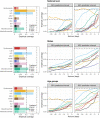Collaborative nowcasting of COVID-19 hospitalization incidences in Germany
- PMID: 37566642
- PMCID: PMC10446237
- DOI: 10.1371/journal.pcbi.1011394
Collaborative nowcasting of COVID-19 hospitalization incidences in Germany
Abstract
Real-time surveillance is a crucial element in the response to infectious disease outbreaks. However, the interpretation of incidence data is often hampered by delays occurring at various stages of data gathering and reporting. As a result, recent values are biased downward, which obscures current trends. Statistical nowcasting techniques can be employed to correct these biases, allowing for accurate characterization of recent developments and thus enhancing situational awareness. In this paper, we present a preregistered real-time assessment of eight nowcasting approaches, applied by independent research teams to German 7-day hospitalization incidences during the COVID-19 pandemic. This indicator played an important role in the management of the outbreak in Germany and was linked to levels of non-pharmaceutical interventions via certain thresholds. Due to its definition, in which hospitalization counts are aggregated by the date of case report rather than admission, German hospitalization incidences are particularly affected by delays and can take several weeks or months to fully stabilize. For this study, all methods were applied from 22 November 2021 to 29 April 2022, with probabilistic nowcasts produced each day for the current and 28 preceding days. Nowcasts at the national, state, and age-group levels were collected in the form of quantiles in a public repository and displayed in a dashboard. Moreover, a mean and a median ensemble nowcast were generated. We find that overall, the compared methods were able to remove a large part of the biases introduced by delays. Most participating teams underestimated the importance of very long delays, though, resulting in nowcasts with a slight downward bias. The accompanying prediction intervals were also too narrow for almost all methods. Averaged over all nowcast horizons, the best performance was achieved by a model using case incidences as a covariate and taking into account longer delays than the other approaches. For the most recent days, which are often considered the most relevant in practice, a mean ensemble of the submitted nowcasts performed best. We conclude by providing some lessons learned on the definition of nowcasting targets and practical challenges.
Copyright: © 2023 Wolffram et al. This is an open access article distributed under the terms of the Creative Commons Attribution License, which permits unrestricted use, distribution, and reproduction in any medium, provided the original author and source are credited.
Conflict of interest statement
The authors have declared that no competing interests exist.
Figures













References
-
- Giannone D, Reichlin L, Small D. Nowcasting: The real-time informational content of macroeconomic data. Journal of Monetary Economics. 2008;55(4):665–676. doi: 10.1016/j.jmoneco.2008.05.010 - DOI
-
- England PD, Verrall RJ. Stochastic claims reserving in general insurance. British Actuarial Journal. 2002;8(3):443–518. doi: 10.1017/S1357321700003809 - DOI
Publication types
MeSH terms
Grants and funding
LinkOut - more resources
Full Text Sources
Medical
Research Materials
Miscellaneous

